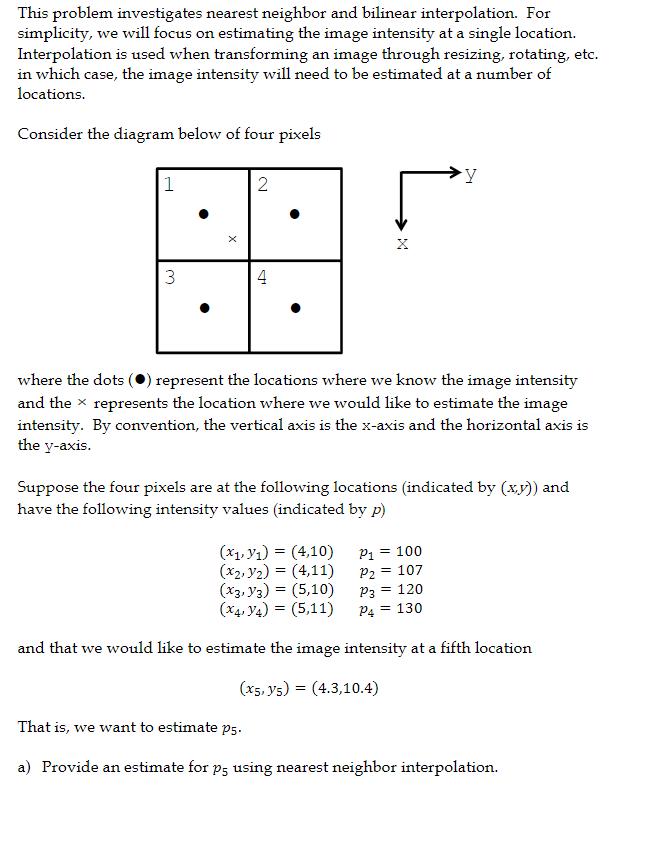simplicity, we will focus on estimating the image intensity at a single location. Interpolation is used when transforming an image through resizing, rotating, etc. in which case, the image intensity will need to be estimated at a number of locations.
simplicity, we will focus on estimating the image intensity at a single location. Interpolation is used when transforming an image through resizing, rotating, etc. in which case, the image intensity will need to be estimated at a number of locations.
Database System Concepts
7th Edition
ISBN:9780078022159
Author:Abraham Silberschatz Professor, Henry F. Korth, S. Sudarshan
Publisher:Abraham Silberschatz Professor, Henry F. Korth, S. Sudarshan
Chapter1: Introduction
Section: Chapter Questions
Problem 1PE
Related questions
Question
Please answer mathmatically

Transcribed Image Text:This problem investigates nearest neighbor and bilinear interpolation. For
simplicity, we will focus on estimating the image intensity at a single location.
Interpolation is used when transforming an image through resizing, rotating, etc.
in which case, the image intensity will need to be estimated at a number of
locations.
Consider the diagram below of four pixels
1
2
3
4
where the dots (0) represent the locations where we know the image intensity
and the x represents the location where we would like to estimate the image
intensity. By convention, the vertical axis is the x-axis and the horizontal axis is
the y-axis.
Suppose the four pixels are at the following locations (indicated by (xy)) and
have the following intensity values (indicated by p)
P1 = 100
= 107
(x1, y1) = (4,10)
(x2, y2) = (4,11)
(x3, y3) = (5,10)
(x4, V4) = (5,11)
P2
P3 =
120
P4 = 130
and that we would like to estimate the image intensity at a fifth location
(x5, y5) = (4.3,10.4)
That is, we want to estimate p5.
a) Provide an estimate for p5 using nearest neighbor interpolation.

Transcribed Image Text:b) Provide an estimate for p5 using bilinear interpolation. Round your value to
the nearest integer. You can use either of the two methods discussed in
lecture. (You might want to use both methods to check your answer.)
Expert Solution
This question has been solved!
Explore an expertly crafted, step-by-step solution for a thorough understanding of key concepts.
This is a popular solution!
Trending now
This is a popular solution!
Step by step
Solved in 2 steps with 1 images

Knowledge Booster
Learn more about
Need a deep-dive on the concept behind this application? Look no further. Learn more about this topic, computer-science and related others by exploring similar questions and additional content below.Recommended textbooks for you

Database System Concepts
Computer Science
ISBN:
9780078022159
Author:
Abraham Silberschatz Professor, Henry F. Korth, S. Sudarshan
Publisher:
McGraw-Hill Education

Starting Out with Python (4th Edition)
Computer Science
ISBN:
9780134444321
Author:
Tony Gaddis
Publisher:
PEARSON

Digital Fundamentals (11th Edition)
Computer Science
ISBN:
9780132737968
Author:
Thomas L. Floyd
Publisher:
PEARSON

Database System Concepts
Computer Science
ISBN:
9780078022159
Author:
Abraham Silberschatz Professor, Henry F. Korth, S. Sudarshan
Publisher:
McGraw-Hill Education

Starting Out with Python (4th Edition)
Computer Science
ISBN:
9780134444321
Author:
Tony Gaddis
Publisher:
PEARSON

Digital Fundamentals (11th Edition)
Computer Science
ISBN:
9780132737968
Author:
Thomas L. Floyd
Publisher:
PEARSON

C How to Program (8th Edition)
Computer Science
ISBN:
9780133976892
Author:
Paul J. Deitel, Harvey Deitel
Publisher:
PEARSON

Database Systems: Design, Implementation, & Manag…
Computer Science
ISBN:
9781337627900
Author:
Carlos Coronel, Steven Morris
Publisher:
Cengage Learning

Programmable Logic Controllers
Computer Science
ISBN:
9780073373843
Author:
Frank D. Petruzella
Publisher:
McGraw-Hill Education